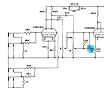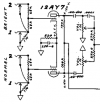DesolationBlvd
Active Member
- Joined
- Sep 16, 2017
- Messages
- 116
- Reaction score
- 155
Years ago, I bought an Electro-Harmonix MIG-50 for bass use with a bass cabinet. The stock circuit has the bass tone stack and no bright cap on the bright channel volume, but smaller PI coupling caps and split cathode like lead spec. I made the changes and snipped the mixer cap so the channels would be even. I would plug my bass into one input and my Minitaur into the other. I also use a 12AY7 so the bottom of the volume range doesn't go from zero to blasting me out of the room so quickly. With my Ampeg 1x15 cabinet, I get a rich and vintage sounding bass tone for the living room and studio.
Then I was studying the evolution of the 5F6A into the JTM45 and then the JMP 1987 / 1986. The mixer cap was what set Marshall apart from the 5F6A. As the price of a new SV20H in the USA is insane, I went through with finishing the mod on my MIG-50 rather than buying an extra SV20H for this project. The chassis already had a hole, I just drilled the front panel to insert the toggle to switch the mixer cap in and out.
The mixer cap is quite a subtle change, but maybe it's because of the 270k mixer resistors instead of the 470k normally used on JMPs. I still prefer it off for bass use most of the time, but with the Rick-O-Sound outputs on my 4001, the cap helps the bridge pickup sound even brighter, to compensate for the darker sound of flats. But this thread is about bass spec amps for guitar use, so I got my ES-335 out and ran into the 1966A with Greenbacks (just the regular 25w 75hz kind). First off, I got fat cleans, and all three settings (no mixer, and the bright and normal channels with the mixer) gave me tone sculpting options beyond just the tone knobs. Lead spec amps like my SV20H are a little tricky to get breakup (not roaring distortion) tones dialed in, balancing the input volumes while jumpered because of the huge bright cap, but bass spec amps get there much more easily. Higher gain settings without the mixer cap revealed the Fender Tweed heritage of the circuit, and with the mixer cap were still recognizably Marshall, just more laid-back. Then I tried all knobs full-out, treble booster into the normal channel, and found a transparent, yet gritty and honking, sound for sleazy glam riffs and responsive blues leads alike.
I haven't tried a 12AX7 yet. Maybe the tone falls apart at the highest gain settings with them? It's also worth noting the MIG-50 is for 5881 / 6L6, not EL34, use.
With an amp that can do both guitar and (vintage recording) bass, I'd love to have a speaker cabinet that can handle bass while still sounding good for guitar.
Then I was studying the evolution of the 5F6A into the JTM45 and then the JMP 1987 / 1986. The mixer cap was what set Marshall apart from the 5F6A. As the price of a new SV20H in the USA is insane, I went through with finishing the mod on my MIG-50 rather than buying an extra SV20H for this project. The chassis already had a hole, I just drilled the front panel to insert the toggle to switch the mixer cap in and out.
The mixer cap is quite a subtle change, but maybe it's because of the 270k mixer resistors instead of the 470k normally used on JMPs. I still prefer it off for bass use most of the time, but with the Rick-O-Sound outputs on my 4001, the cap helps the bridge pickup sound even brighter, to compensate for the darker sound of flats. But this thread is about bass spec amps for guitar use, so I got my ES-335 out and ran into the 1966A with Greenbacks (just the regular 25w 75hz kind). First off, I got fat cleans, and all three settings (no mixer, and the bright and normal channels with the mixer) gave me tone sculpting options beyond just the tone knobs. Lead spec amps like my SV20H are a little tricky to get breakup (not roaring distortion) tones dialed in, balancing the input volumes while jumpered because of the huge bright cap, but bass spec amps get there much more easily. Higher gain settings without the mixer cap revealed the Fender Tweed heritage of the circuit, and with the mixer cap were still recognizably Marshall, just more laid-back. Then I tried all knobs full-out, treble booster into the normal channel, and found a transparent, yet gritty and honking, sound for sleazy glam riffs and responsive blues leads alike.
I haven't tried a 12AX7 yet. Maybe the tone falls apart at the highest gain settings with them? It's also worth noting the MIG-50 is for 5881 / 6L6, not EL34, use.
With an amp that can do both guitar and (vintage recording) bass, I'd love to have a speaker cabinet that can handle bass while still sounding good for guitar.


